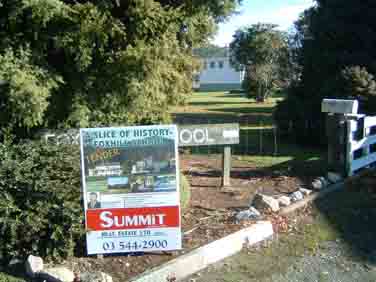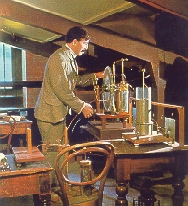|
Other Places
Pickering/Rutherford/Havelock Memorial Location map.

The Pickering/Rutherford/Havelock Memorial is in Havelock, Marlborough Sounds. It was
designed by Heritage Communications of Nelson (www.heritagecommunications.co.nz) and was opened by Bill
Pickering on March 15th 2003. I was project convenor.
If you dont know who Bill Pickering is, see Bill's
biography or look at www.nzedge.com
For more photos
click here.
The site
is on a reserve of the Marlborough District Council, on the main
highway between Blenheim and Nelson and facing the new entrance to Havelock marina.
The site has 8 display panels and two sound stations. The pre-existing
white monument is a memorial to the shipwreck of the Schooner Ronga.
Behind is the Returned Services Memorial.
The
Principal Patrons of this project, without whose support there would have been no memorial at Havelock, were:-
Stout Trust
University of Canterbury
Marlborough District Council
California Institute of Technology
The Royal Society of London
Institute of Physics (UK)
R Wayne and Elizabeth Pickering Mezitt
The Institution of Professional Engineers New Zealand Inc
Pelorus Lodge
Science Societies in New Zealand [IEEE, RSNZ(Cant), NZIP, NZIC,
NZAS, RASNZ]
Panels
1 Geological Formation of the Marlborough Sounds
2 Ngati Kuia Prehistory and History
3 Havelock History
4 Modern Havelock History
5 Rutherford in Havelock
6 Rutherford's Fame
7 Pickering in Havelock
8 Pickering's Fame
Sound Stations
Rutherford 1 Drowning of Charles and Herbert
Rutherford 2 Lecturing
Rutherford 3 Rutherford a Simple Man
Rutherford 4 Mark Oliphant Reminiscing about working with Rutherford
Pickering 1 Bill reminiscing about boyhood in Havelock
Pickering 2 Bill reminiscing about early radio in New Zealand
Pickering 3 Bill reminiscing about the formation of NASA
Pickering 4 James Van Allen reminiscing about Bill Pickering
back to top
Foxhill Memorial


The Foxhill
Memorial is a roadside display outside the Rutherford Memorial Hall next to the Foxhill
School. Location map. The Hall was the brand new school building in Ern's
day. His family lived over the road in a house that was demolished by Cyril Higgins for
new owners about 1969. Being too solid for Cyril's little bulldozer, demolition was completed by burning.
The display tells the story of his life at Foxhill. Opened on the 22nd of Feb 1999, it
was an initiative of the Waimea
South Historical Society and paid for mainly through local sponsors, the Lottery Grants
Board, and the winding up of the Belgrove Country Club. Baric Design (now Heritage
Communication - www.heritagecommunications.co.nz) of Nelson supplied
the design and I supplied the information. This site is an outreach of the Rutherford
Birthplace, part of the Treasured Pathway route and forms part of a Rutherford trail
across the top of the South Island.
The modern Havelock school was adjacent, on the south side. This school was closed and
sold in 2005. It is now a private house.
back
to top
Rutherford
Den - A Brief
History to 2000

The Rutherford Den
is in the Arts Centre of Christchurch, New Zealand. Location map.
Ernest
Rutherford started research at Canterbury College in 1893 as a requirement of his Master's
degree. The college didn't have a physics lab so initially he worked in various spaces in
the Chemistry department, "the old tin shed" but had nowhere where he could
leave his equipment set up. He tried various corridors and then the Great Hall, until it
was needed for end-of-year exams. In the early summer of 1893-4 he worked in one of the
dens below the tiered seating under the Clock tower lecture rooms. It is not known for
sure which one. In April of 1894 he and Jack Erskine applied for the den under the west
end of the clock tower rooms. There he completed the work on the high frequency
magnetisation of iron for which he was to to be awarded an Exhibition of 1851 Scholarship.
Prior to Rutherford, the Den had been used for undergraduates to hang
their gowns when they were leaving the college grounds. In the 1950s it was used as the
rooms for the Christian Students Association. In 1956, when there was a belated move to
honour Rutherford, a bronze marker was mounted on the wall outside this room. In 1977,
when the University of Canterbury completed its shift to its new site at Ilam, the old
Canterbury College buildings were presented to the city for use as an Arts Centre. A
committee comprising representatives of the Arts Centre, the University of Canterbury, the
Royal Society and the Canterbury Museum, was established to make the most of this small
space as a memorial to Rutherford. I was on that committee and suggested the layout that
was adopted. A floor to ceiling window divided the space into half. Behind the window I
and the museum display staff created Rutherford at work. Jack Fergusson (Chemistry) worked
with the display staff to utilise the four remaining bays. They used display panels to
tell the story of the four periods of Rutherford's research life (Cavendish, McGill,
Manchester and Cavendish). A smaller display on the entrance wall told a little of his
life and work in New Zealand. (We were pretty ignorant about this at the time.) The
display was opened on the 20th of September 1978 by Murray Gell-Man, the Nobel Prizewinner
in physics for 1969.
Two directors later in 1986, without consulting the other partners, the
Arts Centre buggered the Den when it wanted the tiered classroom above turned into flat
display space. The Den was a national disgrace for some years thereafter.
The Den and surrounding rooms underwent a major development in 2001 which
was opened on November 8th. Following the 2010/2011 earthquakes, which seriously damaged
the Arts Centre Buildings, the Den was refurbished and opened again on Aug 27th, 2016.
I have had no involvement since the 1990s so you will need to switch to their
website at www.rutherfordsden.org.nz for information about the current display. My final act
was to state they needed to set up a trust specifically for the Den to ensure its future.
This was done.
back to top
Replica Taranaki Lighthouse


The replica lighthouse and museum is at the seaward end of Bayly Road, Warea, at the Cape Egmont Boat
Club clubhouse. It is open Saturday to Monday 11am till 3pm.
The real Cape Egmont lighthouse is 4km south, one road away
at the sea end of Pungerehu Rd, just visible on the horizon in the photograph just to the left of the replica lighthouse.
The Taranaki lighthouse had been visited by Ernest Rutherford when he was based
at his family's flaxmill at Pungarahu whilst he was at Nelson College and Canterbury College.
The actual lighthouse was demanned in 1986. A replica nearby was planned in August 1999
and opened the 2nd of November 2012. Inside were display panels covering local history, including several
covering the Rutherford family history and Ernest's career. The display was done by Bary Jacobsen, of Heritage
Communications, Nelson, who had done the Birthplace display. The replica lighthouse houses the 1850s Fresnel
Prismatic Light that powered the Cape Egmont Light until 1999.
back to top
McGill's Rutherford Museum
This museum houses
the world's best collection of Rutherford apparatus.
We owe the existence of this collection to several people but principally Howard
Barnes, Ern's colleague and one of his first collaborators, at McGill. Usually scientific
equipment continues in use and gets modified out of recognition or cannibalised for use in
other experiments. Barnes argued that Ern was world famous and it would be a crime against
posterity to destroy his apparatus. The equipment was therefore stored in a cupboard,
where it remained undisturbed until 1937. After Rutherford's death, Arthur Eve (ex-McGill)
was asked to write the official biography. Eve wrote to his old colleagues at McGill for
photos of the apparatus to use in his book. (facing page 90). Ferdinand Terroux, a
lecturer and former Cambridge graduate student of Ern's organised the photos. From time to
time the apparatus was taken out of storage to show visitors. In 1950 Ferdinand Terroux
proposed to Norman Shaw, the department chairman, that an official Rutherford Museum and
Conference Room be constructed. In 1964 Norman Shaw bequeathed C$2000 to establish the
museum and the McGill Graduates' Society supplied the rest of the funds for its
construction in one room of the Macdonald Physics Building. The Museum was officially
opened in 1967 and Ferdinand Terroux was appointed the honourary curator, a position he
was proud of for the rest of his life. (I met him in 1982 whilst researching my book.)
Monty Cohen, a medical physicist at McGill, became honorary curator in 1984. (Monty
died of cancer Jan 29th 2002). The current honorary curator is Jean Barrette, a retired nuclear physicist.
In 1977 the Physics department moved to its new building, the Ernest Rutherford building, and the
decision was made to leave the museum in the building in which Rutherford had done his
work. In 1993 this decision was reversed and on the 1st of Oct 1993 a new museum was
opened in a larger room on the first floor of the Physics department. It is open by
appointment only, Monday to Friday. http://www.physics.mcgill.ca/museum/rutherford_museum.htm
The Rutherford Museum is most impressive, though some of the apparatus needed
conservational care as early as 1999. For example, some of the lead was
sprouting white growth.
back to top
The Cavendish Museum
This museum holds some of Rutherford apparatus from his time at the Cavendish
and at Manchester. Several items are on open display in cases on the second level of the
Rutherford Building at The New Cavendish. These include one of his compound detectors used
in his wireless signalling experiments in Cambridge and the device in which he first changed
oxygen into nitrogen (ie split the atom).
back to top
|

